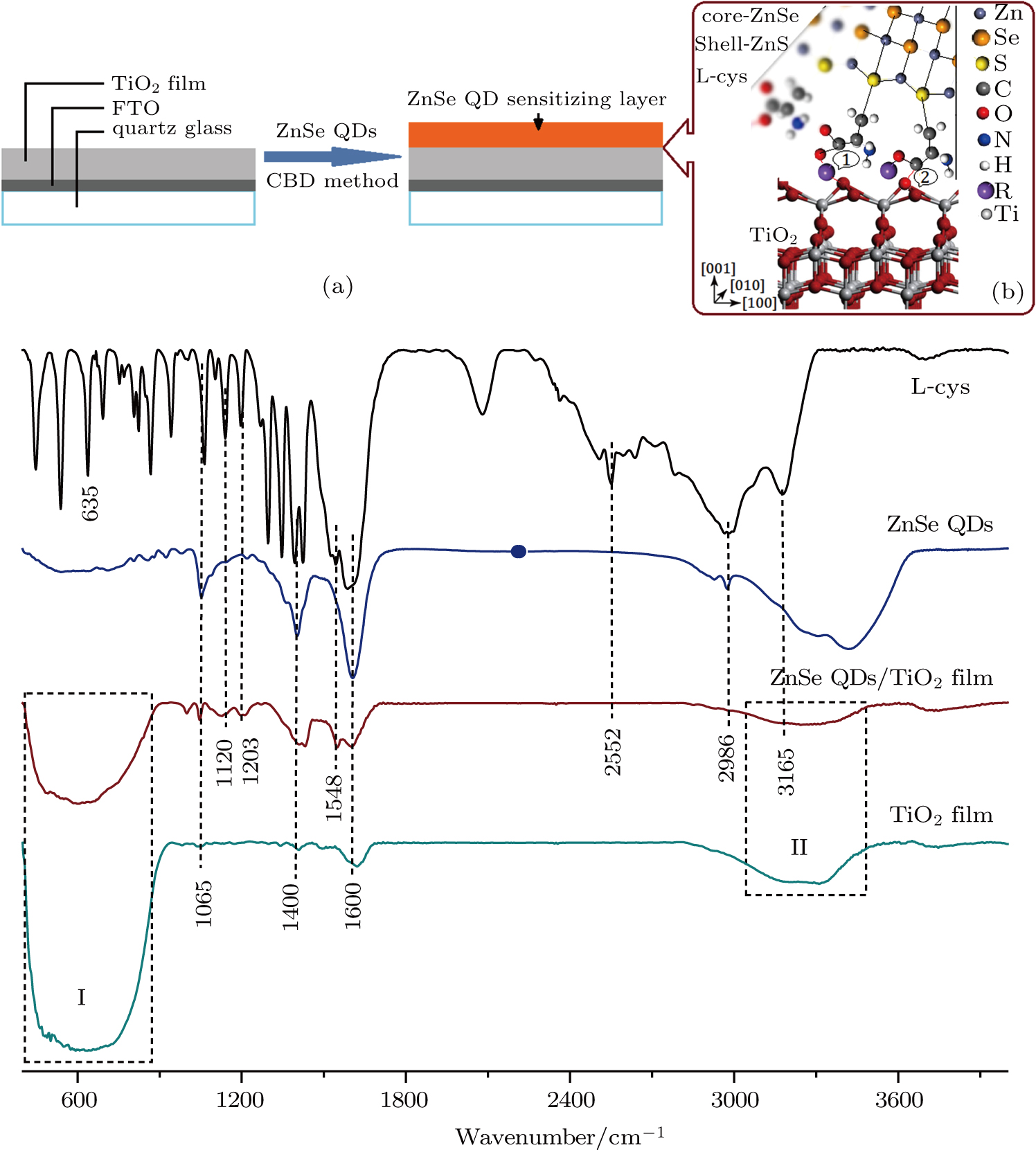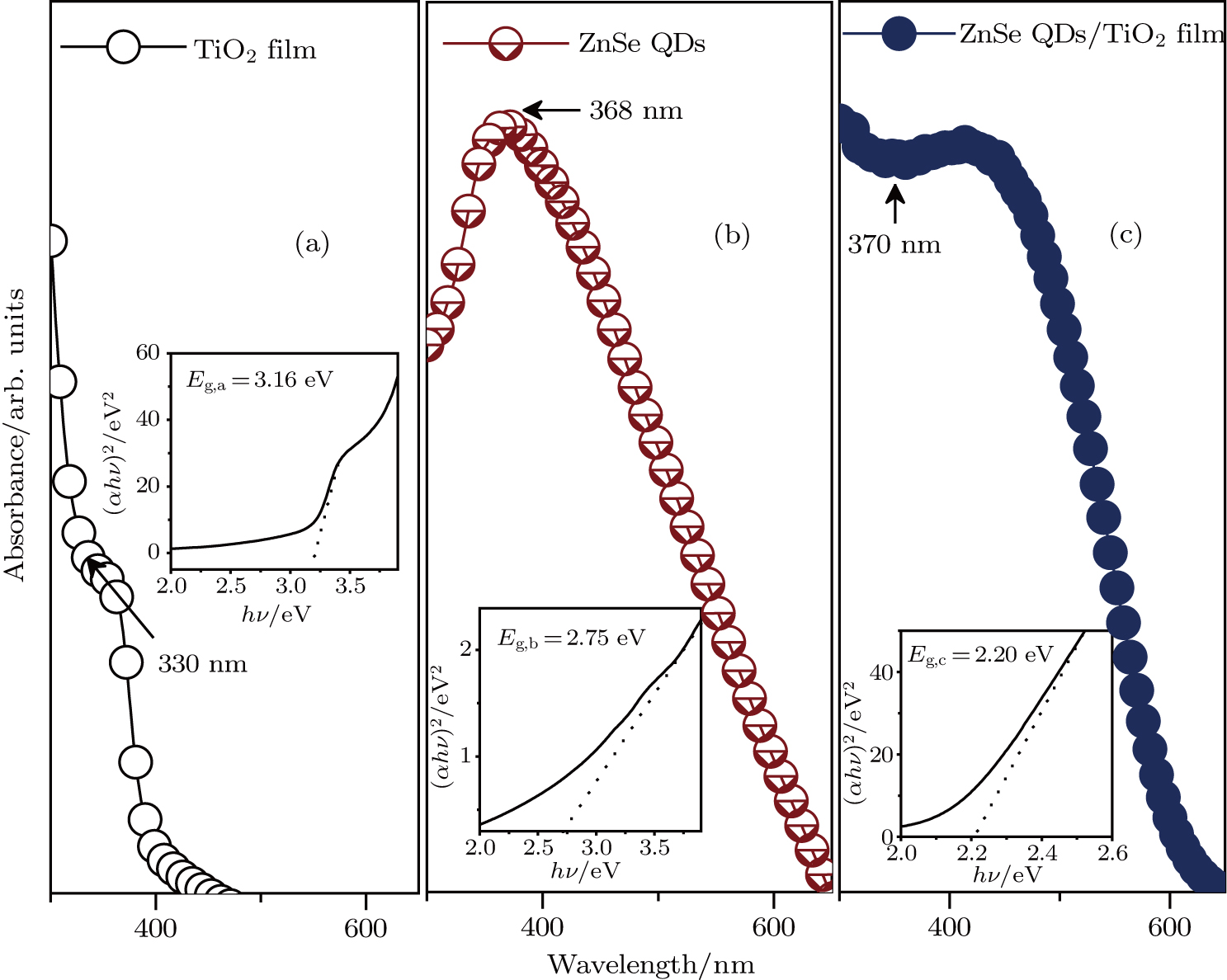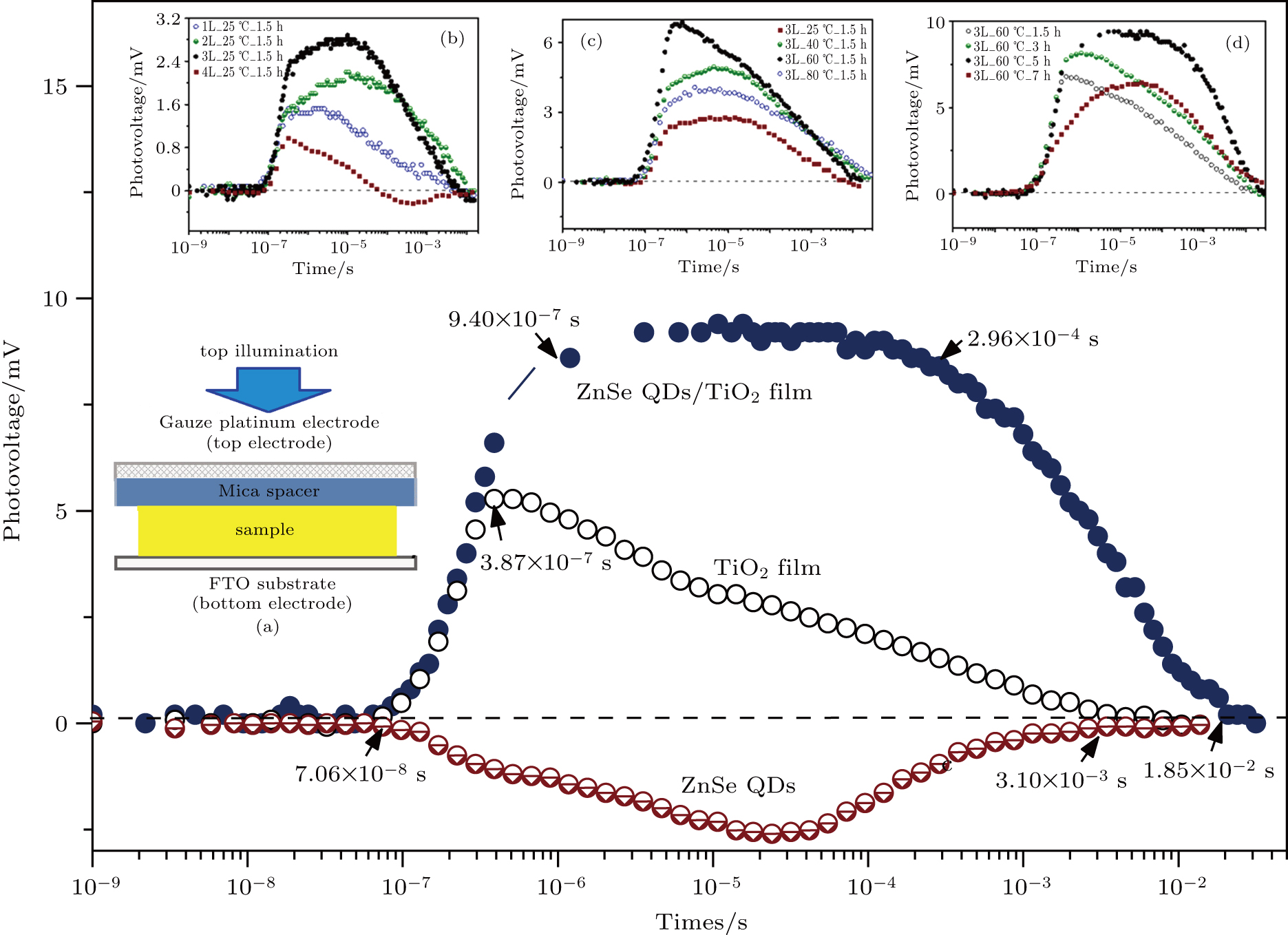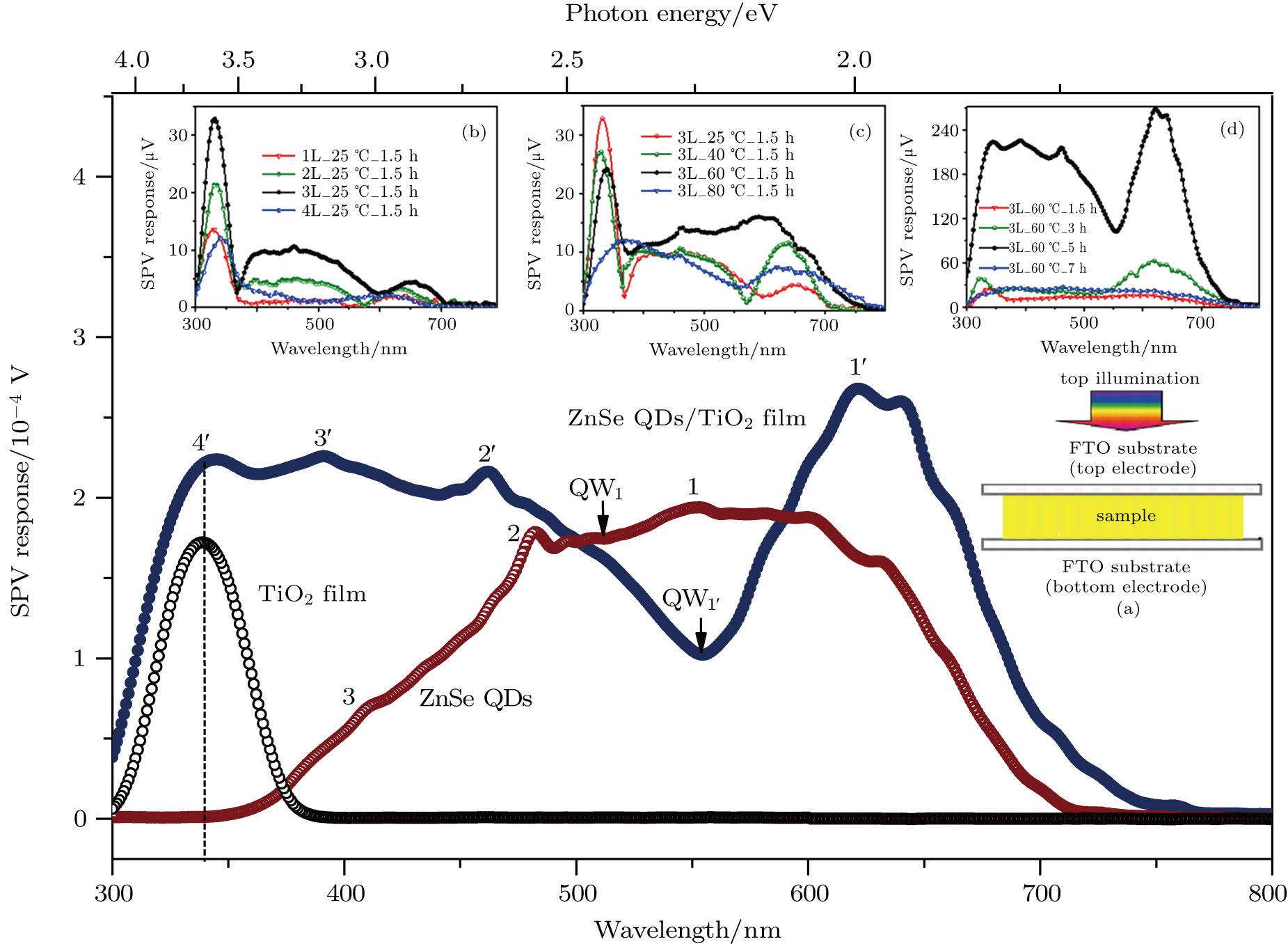Project supported by the Natural Science Foundation of Hebei Province, China (Grant Nos. E2013203296 and E2017203029).
Project supported by the Natural Science Foundation of Hebei Province, China (Grant Nos. E2013203296 and E2017203029).
† Corresponding author. E-mail:
Project supported by the Natural Science Foundation of Hebei Province, China (Grant Nos. E2013203296 and E2017203029).
Photoanodic properties greatly determine the overall performance of quantum-dot-sensitized solar cells (QDSCs). In the present report, the microdynamic behaviors of carriers in the nanocomposite thin-film, a ZnSe QD-sensitized mesoporous La-doped nano-TiO2 thin-film, as a potential candidate for photoanode, are probed via nanosecond transient photovoltaic (TPV) spectroscopy. The results confirm that the L-Cys ligand has a dual function serving as a stabilizer and molecular linker. Large quantities of interface states are located at the energy level with a photoelectric threshold of 1.58 eV and a quantum well (QW) depth of 0.67 eV. This QW depth is approximately 0.14 eV deeper than the depth of QW buried in the ZnSe QDs, and a deeper QW results in a higher quantum confinement energy. A strong quantum confinement effect of the interface state may be responsible for the excellent TPV characteristics of the photoanode. For example, the peak intensity of the TPV response of the QD-sensitized thin-film lasts a long time, from 9.40 × 10−7 s to 2.96 × 10−4 s, and the end time of the PTV response of the QD-sensitized thin-film is extended by approximately an order of magnitude compared with those of the TiO2 substrate and the QDs. The TPV characteristics of the QD-sensitized thin-film change from p-type to n-type for the QDs before and after sensitizing. These properties strongly depend on the extended diffusion length of the photogenerated carries and the reduced recombination rate of photogenerated electron-hole pairs, resulting in prolonged carrier lifetime and an increased level of electron injection into the TiO2 thin-film substrate.
In the past 20 years, quantum dots-sensitized solar cells (QDSCs) have aroused much scientific interest in the field of optical and solar energy.[1–3] Quantum-dot (QD) sensitizers possess unique properties, such as a multi-exciton effect, quantum confinement effect, high excitation coefficient, and low cost.[2] The theoretical conversion efficiency of a QDSC is much higher than those of silicon and dye-sensitized solar cells.[4] However, this high efficiency has not been experimentally achieved.[5–8] Thus, experimentally improving the efficiency is a challenge. In recent years, research on QDSCs has mainly concentrated on their photovoltaic conversion and electrochemical properties.[9–13] The study of the transport mechanism of photoinduced free charge carriers (FCCs) in the photoanode consisting of a wide bandgap semiconductor and QD sensitizer is important because the photoanode is a key component for determining the overall performance of QDSC.[14–17] In the present paper, a mesoporous La-doped nano-TiO2 thin film is used as a substrate material of the photoanode because it has a direct wide bandgap of more than 3.0 eV. Some outstanding properties of the thin film material, such as a large specific surface area and porosity, competent skeleton structure, and particularly good photoelectric features of anatase titanium dioxide, were found in our previous studies.[18,19] In particular, self-assembled core–shell ZnSe/ZnS/L-Cys QDs, which were prepared at room temperature by an aqueous synthesis technique, show superior photoelectronic characteristics and low biotoxicity when compared with other nanocrystalline group II/IV semiconductors.[20,21] Therefore, the ZnSe QDs are used as a sensitizer for the photoanode in our experiments. Some scientific questions arise. How does an effective molecular link form between the ZnSe QDs and mesoporous TiO2 thin film? Does a more efficient transport channel exist for photoinduced FCCs? Additionally, what is the transport mechanism of photoinduced FCCs in the ZnSe QD-sensitized mesoporous nano-TiO2 thin film? Here, we intend to answer these questions experimentally using a chemical bath deposition (CBD) processing method, TPV and steady-state surface photovoltaic (SPV) techniques, Fourier transform infrared (FT-IR) spectroscopy and ultraviolet-visible (UV-VIS) absorption spectroscopy. Transient photovoltaic (TPV) spectroscopy is a non-invasive micro-test method, which is used for exploring microdynamic behaviors of FCCs in semiconductors, such as separation rate of electron-hole pairs and lifetime of FCCs.[22]
A mesoporous La-doped nano-TiO2 thin film was manufactured. Briefly, mesoporous La-doped TiO2 nanoparticles were prepared by sol–gel, a method in which polyethylene glycol (PEG) is used as a template.[21,23] Figure
The ZnSe QD-sensitized mesoporous La-doped nano-TiO2 thin film was prepared by a CBD method.[25,26] Briefly, both selenium and zinc precursor solutions of the ZnSe QD sensitizer were prepared by using L-Cys as a ligand at room temperature.[20] The Se and Zn precursors were mixed in a volume ratio of 1 : 1. The as-prepared mesoporous La-doped nano-TiO2 thin film was first immersed in the mixed solution for a specific time at a given temperature. Then, the ZnSe QD-sensitized nano-TiO2 thin film was obtained after the cleaned thin film had been dried at 60 °C for 2 h.
The x-ray diffraction (XRD; Rigaku D/max-2500/PC, Japan) and high-resolution transmission electron microscopy (HRTEM; JEOL-2010 electron microscope, Tokyo, Japan) were used to study the crystal structures and the average particle size of QDs, respectively. Fourier transform infrared spectroscopy (EQYUBIX55; Bruker, Germany) was used to investigate the vibrational modes and phases of QDs. Ultraviolet-visible (UV-VIS) optical absorption spectra (Lambda35, Perkin–Elmer, USA) of the sample were obtained at room temperature.
Details of the TPV measurements were described elsewhere.[22] In brief, the samples were placed in a cell consisting of a sandwich-like structure of gauze platinum electrode/mica/sample/ITO electrode. The cell was excited by an Nd:YAG laser (Polaris II, New Wave Research, Inc.) with a 5-ns pulse width and 1064-nm ground frequency, which was adjusted using a double-frequency crystal to a wavelength of 355 nm and an intensity of 20 μJ. A photomultiplier was used to collect the reference signal. A 500-MHz digital phosphor oscilloscope (TDS 5054; Tektronix) was used to collect the TPV signals. Details of the SPV measurements were also described elsewhere.[18] In brief, the SPV setup used here is composed of a lock-in amplifier (SR830-DSP), a 500-W xenon lamp — for which the frequency of light was regulated to 23 Hz with a light chopper (SR540) — as a light source, and a sample cell with a sandwich-like structure of indium tin oxide (ITO) electrode/sample/ITO electrode.
The FT-IR absorption spectra of pure L-Cys, the self-assembled core–shell ZnSe/ZnS/L-Cys QDs, the nano-TiO2 thin film, and the ZnSe QD-sensitized nano-TiO2 thin film are displayed in Fig.
 | Fig. 1. (color online) FT-IR absorption spectra of pure L-Cys, self-assembled core–shell ZnSe/ZnS/L-Cys QDs, mesoporous La-doped nano-TiO2 thin film, and ZnSe QD-sensitized nano-TiO2 thin film. Inset (a) shows the cross-section of TiO2 thin film before and after sensitizing. Inset (b) illustrates a possible pattern of molecular linking at the phase interface of the core–shell ZnSe/ZnS/L-Cys QDs and TiO2 thin film.[27] |
However, those peaks marked by red numbers either disappear or weaken in the IR adsorption spectrum of the QD-sensitized thin film. In particular, the stretching vibration band of the S–H bond disappears at 2557 cm−1, whereas the stretching vibration band of the C–S bond at 635 cm−1 weakens and shifts to a higher frequency. The former suggests that the S–H bonds in the L-Cys ligand are broken during the formation of the QDs; the latter is caused by the formation of Zn–S bonds between the ZnSe core and L-Cys as seen in Fig.
Room-temperature UV-VIS adsorption spectra of the as-prepared nano-TiO2 thin film, ZnSe QDs, and ZnSe QD-sensitized nano-TiO2 thin film are shown in Figs.
The values of optical bandgap, Eg, of these samples are estimated using the Tauc relation shown in the insets of Fig.


According to Ref. [22], SPV technologies can also be used effectively to obtain the information about photoelectron behaviors at surfaces and phase interfaces, because the techniques are by no means sensitive only to surfaces. Rather, they are sensitive to the entire surface SCRs by super- or sub-bandgap absorption, even to buried interfaces located anywhere in the sample, as long as they can be reached by photons. The TPV spectra of the nano-TiO2 thin film, the ZnSe QDs, and the QD-sensitized nano-TiO2 thin film are shown in Fig.
First, it is interesting that the QD-sensitized nano-TiO2 photoanode shows n-type TPV characteristics, unlike the ZnSe QDs but similar to the TiO2 thin film, based on the results in Fig.
To further confirm the results above, figure
This implies that the depth of QW1′ is 0.14 eV deeper than that of QW1; a deeper QW will result in a higher quantum confinement energy. We suggest that knee 1′ in Fig.
| Table 1.
Relevant parameters of samples. . |
In summary, the ZnSe QD-sensitized nano-TiO2 photoanode exhibits excellent time-resolved and steady-state photovoltaic characteristics. The results reveal that the L-Cys ligand acts as a molecular linker between the QD sensitizer and the nano-TiO2 thin film substrate mainly by the carboxy groups. A new FCC transport channel, which is formed at the phase interface, may be responsible for the transformation of the TPV characteristics from p-type for the QDs to n-type for the QD-sensitized thin film, and for the enhanced and widened photovoltaic responses of the nanocomposite thin film. The specific microstructures of the interface states between the QDs and the substrate result in prolonged lifetime and diffusion length of photogenerated FCCs. This greatly increases the level of electron injection into the photoanode. In addition, the results confirm that the formula, which was previously proposed by us and was used for evaluating the QW depth in the surface SCR of group II/IV core–shell QDs, also used to evaluate the QW depth in the interface SCR of the nanocomposite film consisting of core–shell ZnSe QDs and La-doped nano-TiO2.
| [1] | |
| [2] | |
| [3] | |
| [4] | |
| [5] | |
| [6] | |
| [7] | |
| [8] | |
| [9] | |
| [10] | |
| [11] | |
| [12] | |
| [13] | |
| [14] | |
| [15] | |
| [16] | |
| [17] | |
| [18] | |
| [19] | |
| [20] | |
| [21] | |
| [22] | |
| [23] | |
| [24] | |
| [25] | |
| [26] | |
| [27] | |
| [28] | |
| [29] | |
| [30] | |
| [31] | |
| [32] |





